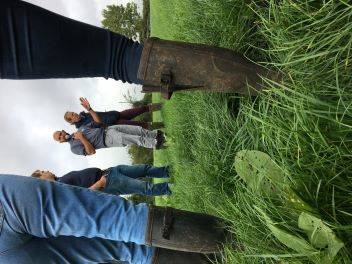- Home
- Knowledge library
- Meet the Forage for Knowledge contributors - Andre van Barneveld
Meet the Forage for Knowledge contributors - Andre van Barneveld
Meet the contributors
Grazing consultant Andre van Barneveld returned to New Zealand to buy a dairy farm. He is challenging himself to put herbal leys and good soil management to the test in commercial milk production.
The business
Andre and his wife Olga bought their farm in June 2021. Located near Lincoln in the South Island of New Zealand, this is Andre’s third dairy farm after a 19-year gap from ownership.
The farm
Altitude: 20 m
Annual rainfall: 700 mm
Soils: loam soil over clay – no irrigation
Topography: flat, in a valley
Milking platform: 120 ha – 88 ha drilled to mixed species
91 ha hill block for dry cows
Potential dry matter from forage: 7 tDM/ha. The 3-year target was 9.6 tDM/ha (= feeds 240 cows from 120 ha and produces 100,000 kgMS). Because the farm was run down, this target has now been extended to five years.
First year production of milk solids: 402 kgMS/cow; herd fed 80 t of palm kernel and 400 bales of bought-in silage.
The cows
The herd of 220 milking cows is managed as a flying herd, mated to beef semen. 40 empty replacement cows are sourced from a nearby herd. Beef cross calves are sold at 4–7 days to local rearers.
Why did you return to dairy farming?
“I wanted a challenge: to convert a dry land farm and prove we could be productive and improve resilience by managing soils and mixed species,” says Andre.
“Working in the UK and Ireland taught me so much about feeding cows, so I’m using this knowledge and doing things differently to 19 years ago. I want to eventually open to group visits and show the whole system. I’ll lay it bare: the good, the bad, the financials and the return on investment.”
What have you learnt so far?
“Herbal leys or mixed species swards are a very complicated area. If you don’t fully commit, it’s an expensive experiment. You need to seriously consider the return on investment. We go the wrong way round; we think the swards improve the soil, whereas if you want them to last, the soil needs to change before the swards can perform,” he says.
“You have to be incredibly thoughtful and get the right mix in the right area. For instance, the front of our farm is sand based and the surface can get to over 40°C in summer, whereas the middle soils risk saturation and stay cooler. We are dealing with different environments. Soils low in phosphate won’t suit brome or chicory as they are very phosphate hungry and won’t survive; lucerne doesn’t like wet soils.”
What’s your plan?
“We are following a regeneration crop scenario where we sacrifice production initially to improve soils for the following mixed species. We want to build organic matter by 3–4% because every extra 1% of organic matter is equivalent to 18 mm of rainfall in increased soil moisture retention.
“Crops such as lucerne, chicory and forage radish are truly deep rooting,” says Andre, pointing out that radish goes down to 30–40 cm with its tap root. “This punches through a pan and the root is left in the soil when the plant dies which creates organic matter. We cropped peas and oats together and it was our best paddock by far with well-conditioned soils and the following plants really got going.”
He has 12 ha comprising grasses, cereals, legumes, brassicas and chenopods (silver beet family). These crops target different soil fertility and open up compacted soils, thus reducing mechanical intervention.
How are you adapting grazing management to herbal leys?
“If you want specific plants to dominate in the sward, you have to identify what conditions favour those plants. Without doubt, management needs to change because short-round rotational grazing favours ryegrass. We were on a 22-day rotation all last year. Now we have 88 ha of mixed species, from October we will go to a 30-plus day rotation and more likely a 40-day.”
Measuring and analysing mixed swards remains tricky. For now, Andre is using a plate meter as a guide, but mostly doing it by eye and using the cows as a back calculation.
Nutrient policy
Andre has applied 620 t of lime and his aim is to use around 35 kgN/ha/year. “There is a place for using some of it – I’m not organic. We are also spreading 11.5 t of a fish-based fertiliser, which has some chemical content and acts as a soil conditioner. Analysis is 11% N and 10% P so at 200 kg/ha, the pasture will still get a hit.”
 AHDB
AHDB

